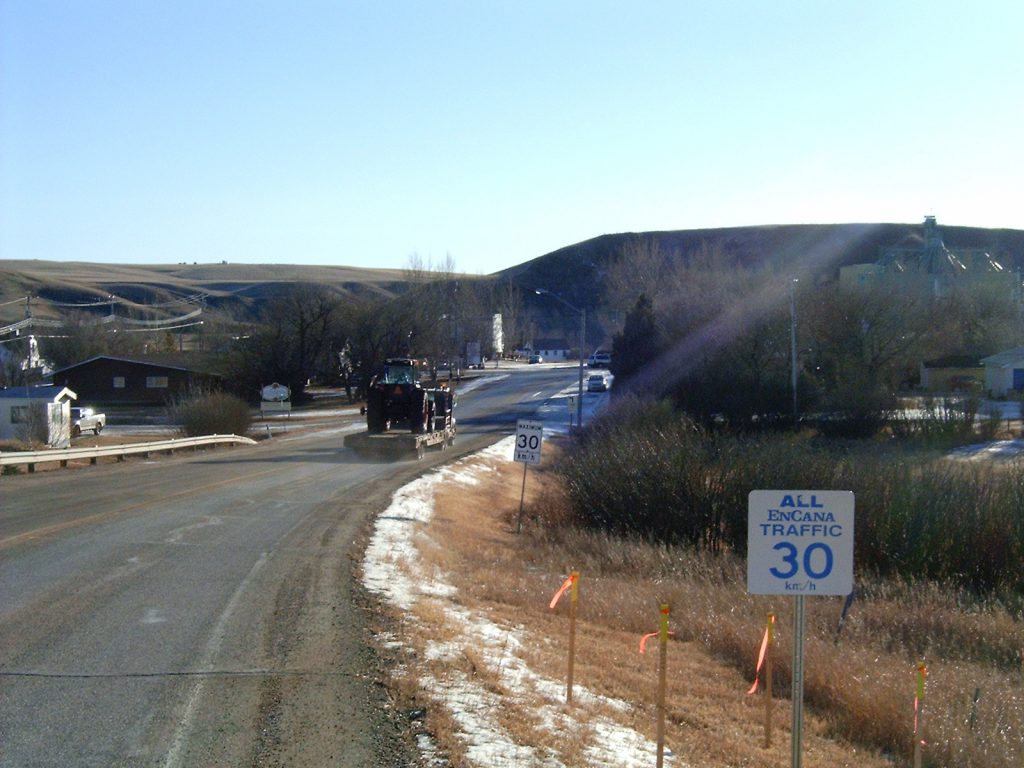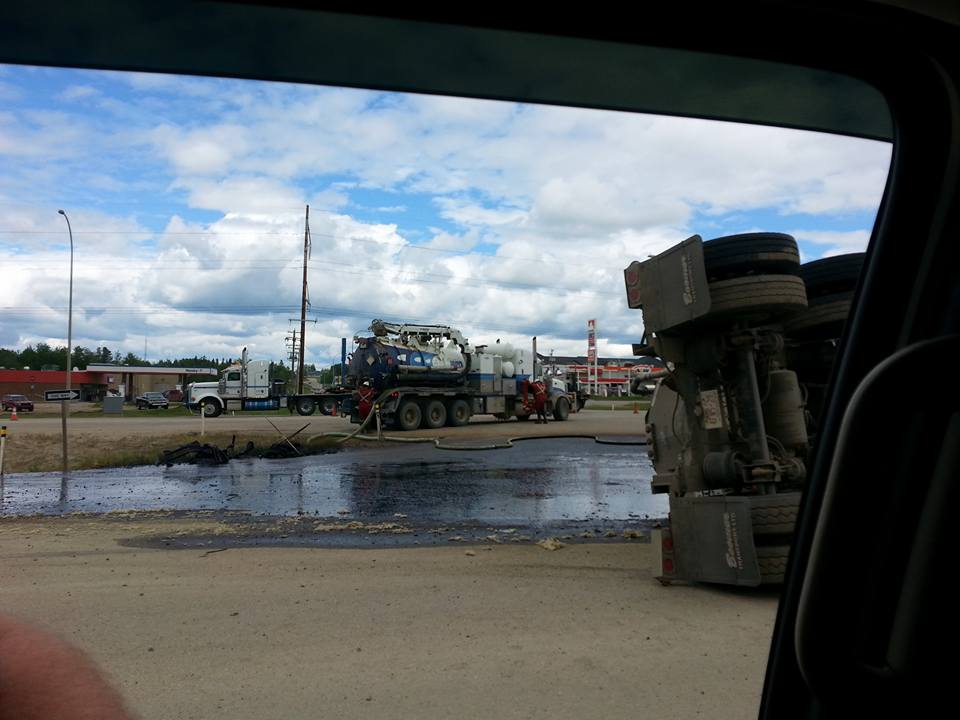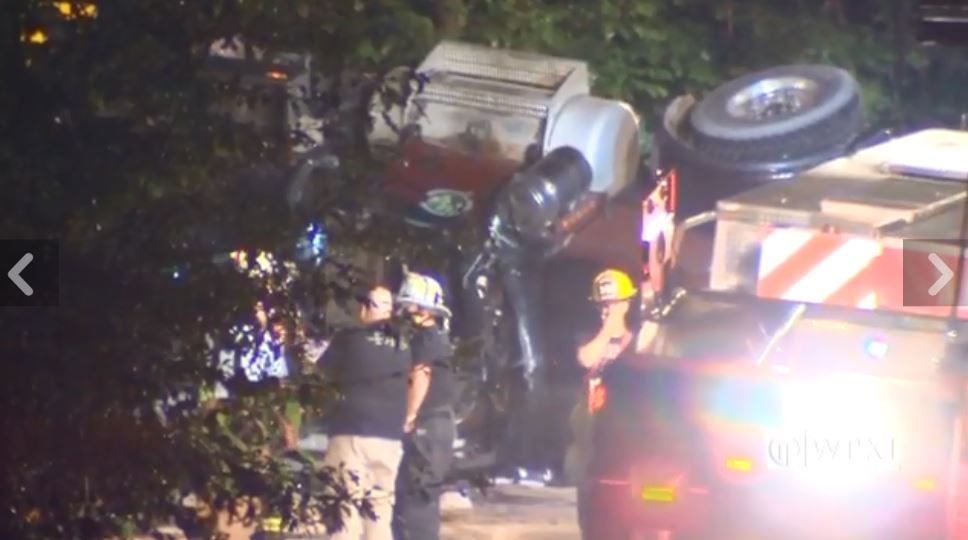In my community during the frac boom, Encana (now Ovintiv) and Trican trucks often raced through the playground zone, sometimes going 90 km/hr in the 30 km/hr zone. One parked vehicle was hit and damaged; residents were nearly killed, including a six year old crossing the highway to catch the school bus – in heavy fog.
The community bitterly complained, worried for the safety of residents and homes and businesses along the highway. Encana installed (in the highway right-of-way) their own maximum speed signs in front of the official highway speed signs already there, which is illegal, and of course did nothing to slow the dangerous frac traffic. Just another PR stunt.
I asked the highway regulator for regulation. Like all Canadian authorities, they bullied me and did not hold Encana accountable for breaking the law.
I asked the RCMP to randomly do speed checks in our playground zone for the sake of the children and students. They told me that King Ralph Klein (then Alberta premier) did not want police interfering in the oil patch or slowing it down, and did not give them any budget to police industry. They also refused to hold Encana accountable. (Years later, the police had the funding drive to and invade my private property to try to intimidate me into silence and dropping my lawsuit).

Rosebud’s playground is to the right of the signs. The sign you see above with flagging around it, is the same sign in the photo below:

Authorities also refused to install playground warning signs in our community because they told me that would slow the frac’ers down which Encana did not want.

Fraccidents: The Impact of Fracking on Road Traffic Deaths by Minhong Xu and Yilan Xu, May 28, 2019, Journal of Environmental Economics and Management
Abstract
Hydraulic fracturing, a.k.a., fracking, requires intense truck trips to transport a large volume of water within a narrow time window, posing a safety threat to other road users. This paper examines how fracking-related trucking affects fatal crashes in
North Dakota using the exogenous timing of fracking operations near a road
segment. The results show that an additional post-fracking well within six miles of
a road segment led to 8% more fatal crashes and 7.1% higher per-capita costs in
accidents. Transport activities at wells’ other operational stages did not affect fatal
crashes. These additional crashes emerged mainly from collisions involving trucks,
resulting from a higher traffic volume rather than a higher crash rate and occurring
during daytime rush hours rather than during the rest of the day. Alcohol-involved
crash drivers increased most likely due to their vulnerability to heavier fracking induced traffic rather than more alcohol-involved truck drivers near the fracking sites. …

Paper: Disposal of wastewater from hydraulic fracturing poses dangers to drivers by Phil Ciciora, Mar 2, 2020, news.illinois.edu
CHAMPAIGN, Ill. — Environmental concerns about hydraulic fracturing…are well documented, but according to a paper co-written by a University of Illinois at Urbana-Champaign environmental economics expert, the technique also poses a serious safety risk to local traffic.
New research from Yilan Xu (“E-Lan SHE”), a professor of agricultural and consumer economics at Illinois, shows that the growing traffic burden in fracking boomtowns from trucks hauling wastewater to disposal sites resulted in a surge of road fatalities and severe accidents.
“Fracking requires large amounts of water, and it subsequently generates a lot of wastewater,” she said. “When trucks need to transport all that water within a narrow window of time to a disposal site, that poses a safety threat to other drivers on the road – especially since fracking occurs mostly in these boomtowns where the roadway infrastructure isn’t built up enough to handle heavy truck traffic.”
The study examined how fracking-related trucking affected the number of fatal crashes in the Bakken Formation in North Dakota from 2006-14, using the timing of fracking operations near certain road segments.
The researchers identified a causal link between fracking-related trucking and fatal traffic crashes, finding that an additional post-fracking well within six miles of the road segments led to 8% more fatal crashes and 7.1% higher per-capita costs in accidents.
“Our back-of-the-envelope calculation suggests that an additional 17 fatal crashes took place per year across the sampled road segments, representing a 49% increase relative to the annual crash counts of the drilling counties in North Dakota in 2006,” Xu said. “That’s a significant number when you’re talking about a sparsely populated area like North Dakota.
“And besides the fatality and injury costs in fatal crashes quantified in our study, other costs may occur as well, including injury costs in nonfatal crashes and indirect expenditures on emergency services, insurance administrative costs, and infrastructure maintenance and replacement.”
To lessen the negative impact on traffic fatalities as well as the severity of traffic accidents, the study proposes a tax that can be charged per well to internalize the costs of fracking-related trucking activities, similar to the impact fees implemented in energy-rich towns in Pennsylvania that yield hundreds of millions of dollars per year for the state. ![]() Money won’t bring back the dead, those killed by speed maniac frac truckers.
Money won’t bring back the dead, those killed by speed maniac frac truckers.![]()
“The tax could serve as an economic instrument that affects operators’ drilling and fracking decisions and thus alleviate the hazard of the associated truck traffic indirectly,” Xu said. “Likewise, a toll fee by miles driven by trucks could be collected on highways to absorb the negative impacts of fracking-related trucking.”
The study also sheds light on more practical measures that local governments can undertake to curb the traffic risks associated with fracking.
“Since many fracking-induced fatal crashes take place in the daytime rush hours, local governments could adopt policies such as making a high occupancy vehicle lane for trucks carrying wastewater. An active traffic alert and warning system with live well-operations updates could also help drivers monitor traffic and avoid exposure to road hazards,” she said. Moreover, the paper calls for the active involvement of the oil and gas industry to seek ways to improve their workplace safety and mitigate the traffic hazard of fracking to road users. ![]() What? Interfere with profits for the rich, just to save some lives of locals and reduce taxpayer burdens? Corporate CEOs and their enabling politicians and deregulators will never allow it.
What? Interfere with profits for the rich, just to save some lives of locals and reduce taxpayer burdens? Corporate CEOs and their enabling politicians and deregulators will never allow it.![]()
“Our findings suggest that oil and gas operators could redistribute the traffic loads over time to avoid concentrated water hauling during peak hours,” Xu said. “In the long run, since a well may need to be fracked multiple times over its productive life, operators may improve the water supply system by constructing water wells serving multiple well pads via a piping system. They could also develop the onsite wastewater treatment and disposal facilities as opposed to trucking wastewater over long distances. Such measures would reduce the long-term transport costs and the associated traffic effects.”
The findings should give local and federal policymakers information when conducting due diligence ![]() No Frac’ing Way do law or policymakers or courts in North America give a damn about “due diligence” when it comes to the oil and gas and frac industry. Frac’ing free-for-all rules the Rule of Law.
No Frac’ing Way do law or policymakers or courts in North America give a damn about “due diligence” when it comes to the oil and gas and frac industry. Frac’ing free-for-all rules the Rule of Law.![]() and evaluating the regional costs and benefits of shale energy development, Xu said.
and evaluating the regional costs and benefits of shale energy development, Xu said.
“Our study provides an estimate based on the North Dakota experience where population density and traffic volume is relatively low, but our findings have implications for other regions planning future shale development.”
The paper, which was co-written by Minhong Xu of Nanjing Audit University, was published in the Journal of Environmental Economics and Management.

Refer also to:








RCMP getting help from Alberta to clean up acid spill, Truck crashed north of Swift Current
Two Children Dead After Water Truck Overturns on Sedan in Harrison County
… A water truck was seen laying on top of a four-door sedan.



